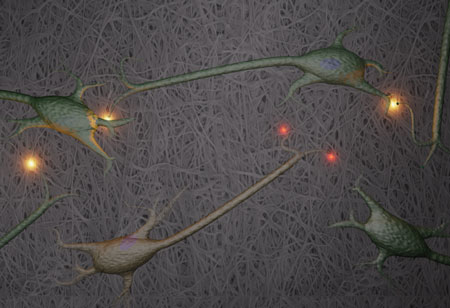| Mar 19, 2012 |
Nerve cells grow on nanocellulose
|
|
(Nanowerk News) Researchers from Chalmers and the University of Gothenburg have shown that nanocellulose stimulates the formation of neural networks. This is the first step toward creating a three-dimensional model of the brain. Such a model could elevate brain research to totally new levels, with regard to Alzheimer's disease and Parkinson's disease, for example.
|
|
Over a period of two years the research group has been trying to get human nerve cells to grow on nanocellulose.
|
 |
| Nerve cells growing on a three-dimensional nanocellulose scaffold. One of the applications the research group would like to study is destruction of synapses between nerve cells, which is one of the earliest signs of Alzheimer's disease. Synapses are the connections between nerve cells. In the image, the functioning synapses are yellow and the red spots show where synapses have been destroyed. (Illustration: Philip Krantz, Chalmers)
|
|
"This has been a great challenge," says Paul Gatenholm, Professor of Biopolymer Technology at Chalmers.?Until recently the cells were dying after a while, since we weren't able to get them to adhere to the scaffold. But after many experiments we discovered a method to get them to attach to the scaffold by making it more positively charged. Now we have a stable method for cultivating nerve cells on nanocellulose."
|
|
When the nerve cells finally attached to the scaffold they began to develop and generate contacts with one another, so-called synapses. A neural network of hundreds of cells was produced. The researchers can now use electrical impulses and chemical signal substances to generate nerve impulses, that spread through the network in much the same way as they do in the brain. They can also study how nerve cells react with other molecules, such as pharmaceuticals.
|
|
The researchers are trying to develop ?artificial brains", which may open entirely new possibilities in brain research and health care, and eventually may lead to the development of biocomputers. Initially the group wants to investigate destruction of synapses between nerve cells, which is one of the earliest signs of Alzheimer's disease. For example, they would like to cultivate nerve cells and study how cells react to the patients' spinal fluid.
|
|
In the future this method may be useful for testing various pharmaceutical candidates that could slow down the destruction of synapses. In addition, it could provide a better alternative to experiments on animals within the field of brain research in general.
|
|
The ability to cultivate nerve cells on nanocellulose is an important step ahead since there are many advantages to the material.
|
|
?Pores can be created in nanocellulose, which allows nerve cells to grow in a three-dimensional matrix. This makes it extra comfortable for the cells and creates a realistic cultivation environment that is more like a real brain compared with a three-dimensional cell cultivation well," says Paul Gatenholm.
|
|
Paul Gatenholm says that there are a number of new biomedical applications for nanocellulose. He is currently also leading other projects that use the material, for example a project where researchers are using nanocellulose to develop cartilage to create artificial outer ears. His research group has previously developed artificial blood vessels made of nanocellulose, which are being evaluated in pre-clinical studies.
|
|
Research on new application areas for nanocellulose is of major strategic significance for Sweden. Several projects are financed by the Knut and Alice Wallenberg Foundation and being conducted in collaboration between Chalmers and KTH within the Wallenberg Wood Science Center, WWSC.
|
|
The results will be presented at the American Chemical Society Meeting in San Diego, 25 March.
|
|
Facts about nanocellulose
|
|
Nanocellulose is a material that consists of nanosized cellulose fibers. Typical dimensions are widths of 5 to 20 nanometers and lengths of up to 2,000 nanometers. Nanocellulose can be produced by bacteria that spin a close-meshed structure of cellulose fibers. It can also be isolated from wood pulp through processing in a high-pressure homogenizer.
|
|
|

